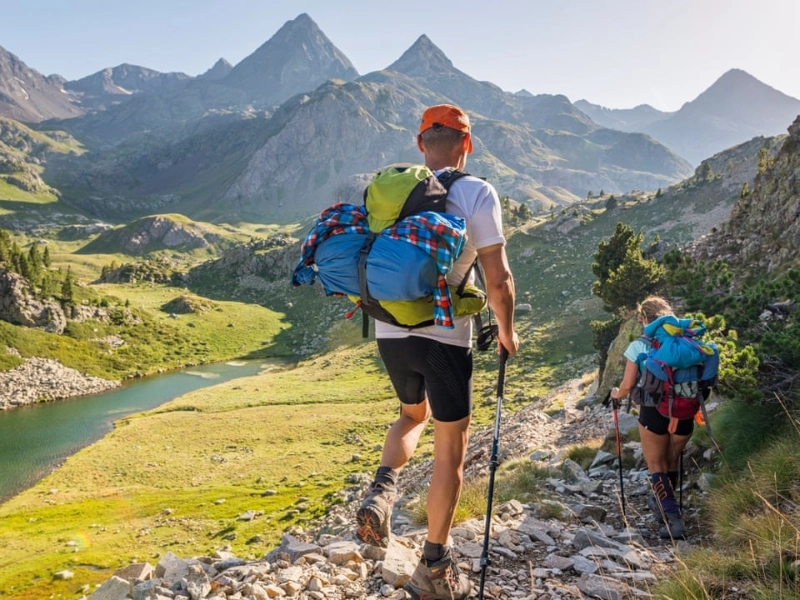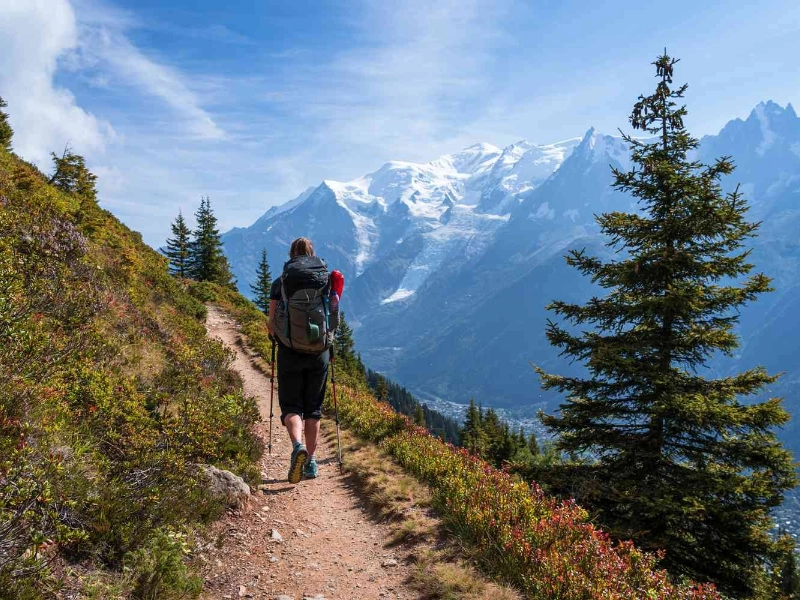Hiking is a great kind of exercise that has several health advantages, such as lowering the risk of depression, heart disease, and diabetes. It's crucial to understand the distinction between walking and hiking, though. Walking is usually done on level surfaces like paved walkways or sidewalks, and it usually entails going from one place to another with a specific destination in mind. On the other hand, hiking usually entails crossing rough terrain, such as hills or rocky routes.

 Hikers should dress appropriately for the day's weather and terrain. This consists of an outer shell to ward off wind and precipitation, an insulating midlayer, and a base layer that wicks moisture away.
For trekking, a synthetic fabric that breathes well is the ideal base layer. Polypropylene or polyester are the finest choices. In addition to being sturdy, these wick away perspiration effectively, keeping the hiker dry and comfy.
A pullover made of fleece or wool is perfect for the insulating midlayer. This adds warmth without adding excessive bulk in cold weather. A lightweight jacket with a zipper can also offer the essential ventilation for warm climates or brisk wind gusts.
Rainwear that is waterproof is required for the outer shell. To lessen chafing against backpack straps, the garment should also have a drawstring at the waist. A pair of trekking socks is also recommended for the hiker. Investing in high-quality hiking shoes is advised because blisters are an unwelcome hiking companion.
Hikers should dress appropriately for the day's weather and terrain. This consists of an outer shell to ward off wind and precipitation, an insulating midlayer, and a base layer that wicks moisture away.
For trekking, a synthetic fabric that breathes well is the ideal base layer. Polypropylene or polyester are the finest choices. In addition to being sturdy, these wick away perspiration effectively, keeping the hiker dry and comfy.
A pullover made of fleece or wool is perfect for the insulating midlayer. This adds warmth without adding excessive bulk in cold weather. A lightweight jacket with a zipper can also offer the essential ventilation for warm climates or brisk wind gusts.
Rainwear that is waterproof is required for the outer shell. To lessen chafing against backpack straps, the garment should also have a drawstring at the waist. A pair of trekking socks is also recommended for the hiker. Investing in high-quality hiking shoes is advised because blisters are an unwelcome hiking companion.
 Although hiking is a well-liked pastime, it may potentially negatively affect nature protected areas. By staying on designated paths and avoiding detours, hikers can reduce their environmental effect. Departures can result in soil erosion and compaction, disrupt wildlife habitats, and introduce dangerous species.
Through funding campaigns and education initiatives, hikers contribute to the preservation of wilderness areas and the environment. Hiking's growing popularity has also contributed to a greater understanding of the value of connecting with nature.
Numerous other outdoor pursuits and sports, including mountain climbing, backpack camping, birdwatching, cross-country skiing and snowshoeing, orienteering, and hunting, all stem from hiking. For athletes, it is a crucial component of their physical preparation. Numerous research indicates that hiking improves mental health by lowering anxiety and raising happiness because it takes place outside. Hiking's meditative element lowers stress and enhances the quality of sleep. People who suffer from persistent depression, anxiety, or other mental health issues can particularly benefit from this.
Although hiking is a well-liked pastime, it may potentially negatively affect nature protected areas. By staying on designated paths and avoiding detours, hikers can reduce their environmental effect. Departures can result in soil erosion and compaction, disrupt wildlife habitats, and introduce dangerous species.
Through funding campaigns and education initiatives, hikers contribute to the preservation of wilderness areas and the environment. Hiking's growing popularity has also contributed to a greater understanding of the value of connecting with nature.
Numerous other outdoor pursuits and sports, including mountain climbing, backpack camping, birdwatching, cross-country skiing and snowshoeing, orienteering, and hunting, all stem from hiking. For athletes, it is a crucial component of their physical preparation. Numerous research indicates that hiking improves mental health by lowering anxiety and raising happiness because it takes place outside. Hiking's meditative element lowers stress and enhances the quality of sleep. People who suffer from persistent depression, anxiety, or other mental health issues can particularly benefit from this.
 Exercise outside offers numerous advantages, whether you're walking in the park or trekking in the mountains. In addition to burning calories and promoting healthy blood pressure, hiking increases bone density and fortifies leg muscles. Additionally, it raises your exposure to vitamin D, which helps balance your circadian rhythm and boosts the release of melatonin at night, both of which enhance sleep patterns.
Hiking strengthens more than just your legs; it tones all of your muscles. The uneven nature of the terrain along with the hike's uphill and downhill sections work your quads, hamstrings, and calves quite hard. Additionally, hiking forces you to move in numerous planes of motion, strengthening the muscles that are usually the weakest during these kinds of activities and helping to enhance stability and injury prevention.
The degree of difficulty of the terrain you are hiking across is the main difference between hiking and walking. When you first start out, keep to walking on trails that are easier to access, then gradually go to more difficult terrain.
Exercise outside offers numerous advantages, whether you're walking in the park or trekking in the mountains. In addition to burning calories and promoting healthy blood pressure, hiking increases bone density and fortifies leg muscles. Additionally, it raises your exposure to vitamin D, which helps balance your circadian rhythm and boosts the release of melatonin at night, both of which enhance sleep patterns.
Hiking strengthens more than just your legs; it tones all of your muscles. The uneven nature of the terrain along with the hike's uphill and downhill sections work your quads, hamstrings, and calves quite hard. Additionally, hiking forces you to move in numerous planes of motion, strengthening the muscles that are usually the weakest during these kinds of activities and helping to enhance stability and injury prevention.
The degree of difficulty of the terrain you are hiking across is the main difference between hiking and walking. When you first start out, keep to walking on trails that are easier to access, then gradually go to more difficult terrain.